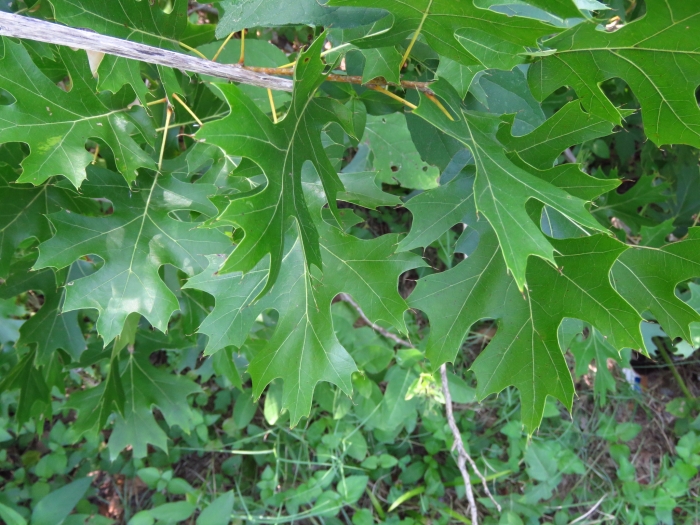Shumard Oak
(Quercus shumardii)
Shumard Oak (Quercus shumardii)
/
/

Annika Lindqvist
CC BY 4.0
Image By:
Annika Lindqvist
Recorded By:
Copyright:
CC BY 4.0
Copyright Notice:
Photo by: Annika Lindqvist | License Type: CC BY 4.0 | License URL: http://creativecommons.org/licenses/by/4.0/ | Rights Holder: Annika Lindqvist | Publisher: iNaturalist | Date Created: 2020-09-08T16:25:38-07:00 |















































































Estimated Native Range
Summary
Quercus shumardii, commonly known as Shumard Oak, is a deciduous tree native to bottomland forests, floodplains, and along streams in the Eastern and Central United States. It is a large tree, typically reaching heights of 25 to 35 meters (82 to 115 feet), with a trunk diameter of 60 to 100 centimeters (24 to 39 inches), and a crown width of 12 to 18 meters (39 to 59 ft). Shumard Oak is notable for its straight, vertical trunk and deeply fluted buttresses. The bark is light gray and smooth in young trees, becoming darker and ridged with age. The leaves are a vibrant green, turning to shades of brown, red, and sometimes yellow in the fall. Acorns are large, up to 3 cm in diameter, and mature over 1.5 to 3 years. This species can live for several centuries, with some individuals known to be over 480 years old.
Shumard Oak is valued for its hardiness, adaptability to various soil types, and tolerance to different pH levels. It is drought-resistant and thrives in partial to full sunlight. The tree is often used as a shade tree in urban and residential settings due to its large size and attractive fall coloration. It requires full sun and medium water, and can adapt to a range of soil drainage conditions. While it is tolerant of temporary flooding, its roots are sensitive to disturbance. Care should be taken to avoid damaging the root system during landscaping or construction activities.CC BY-SA 4.0
Shumard Oak is valued for its hardiness, adaptability to various soil types, and tolerance to different pH levels. It is drought-resistant and thrives in partial to full sunlight. The tree is often used as a shade tree in urban and residential settings due to its large size and attractive fall coloration. It requires full sun and medium water, and can adapt to a range of soil drainage conditions. While it is tolerant of temporary flooding, its roots are sensitive to disturbance. Care should be taken to avoid damaging the root system during landscaping or construction activities.CC BY-SA 4.0
Plant Description
- Plant Type: Tree
- Height: 40-60 feet
- Width: 30-40 feet
- Growth Rate: Moderate
- Flower Color: N/A
- Flowering Season: Spring
- Leaf Retention: Deciduous
Growth Requirements
- Sun: Full Sun
- Water: Medium
- Drainage: Fast, Medium, Slow
Common Uses
Bee Garden, Bird Garden, Butterfly Garden, Drought Tolerant, Fire Resistant, Low Maintenance, Rabbit Resistant, Street Planting
Natural Habitat
Bottomland forests, floodplains, and along streams in the Eastern and Central United States
Other Names
Common Names: Shumard Oak, Shumard Red Oak, Spotted Oak, Swamp Red Oak, Southern Red Oak, Schneck Oak, Chêne De Shumard
Scientific Names: , Quercus shumardii,
GBIF Accepted Name: Quercus shumardii Buckley